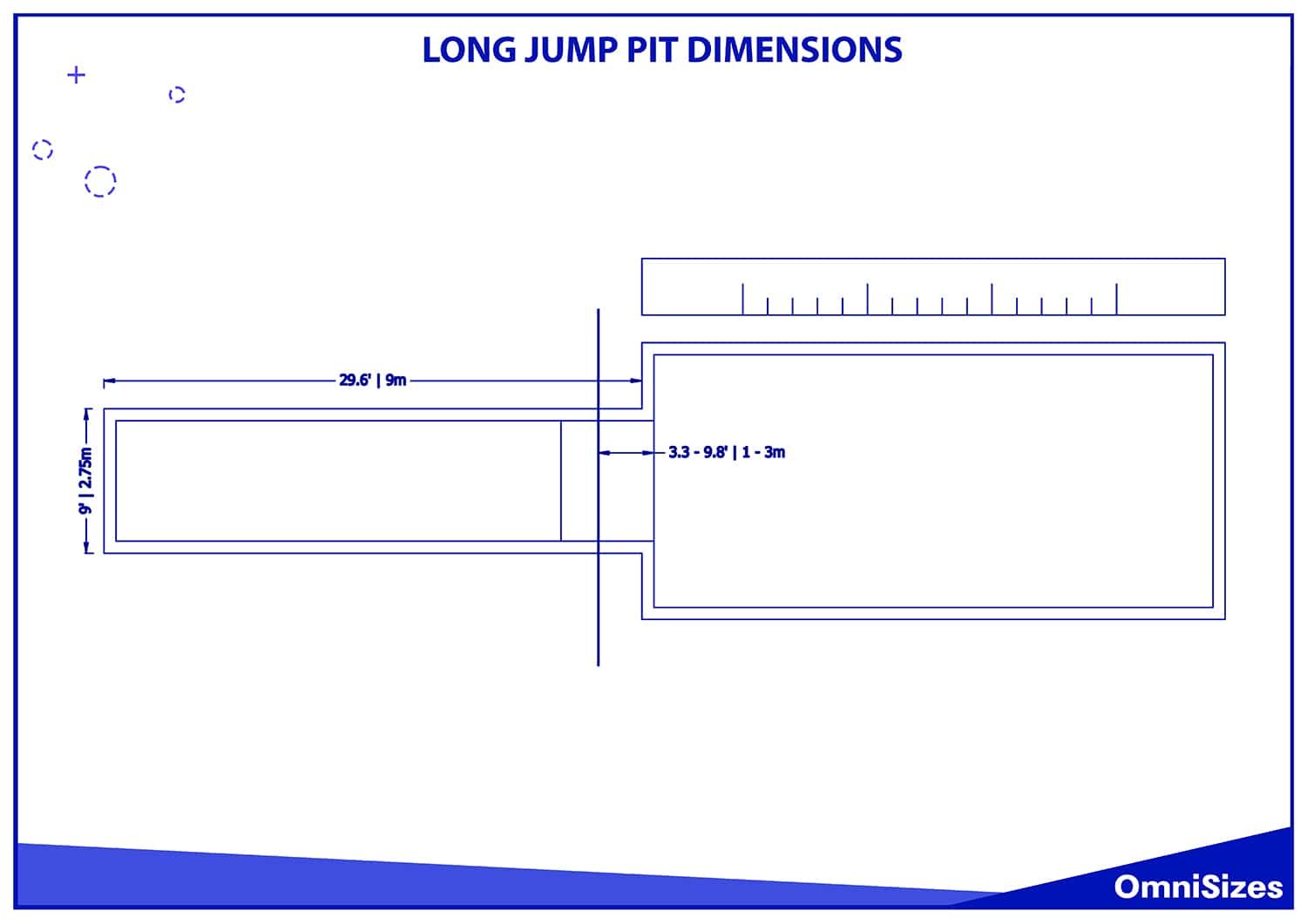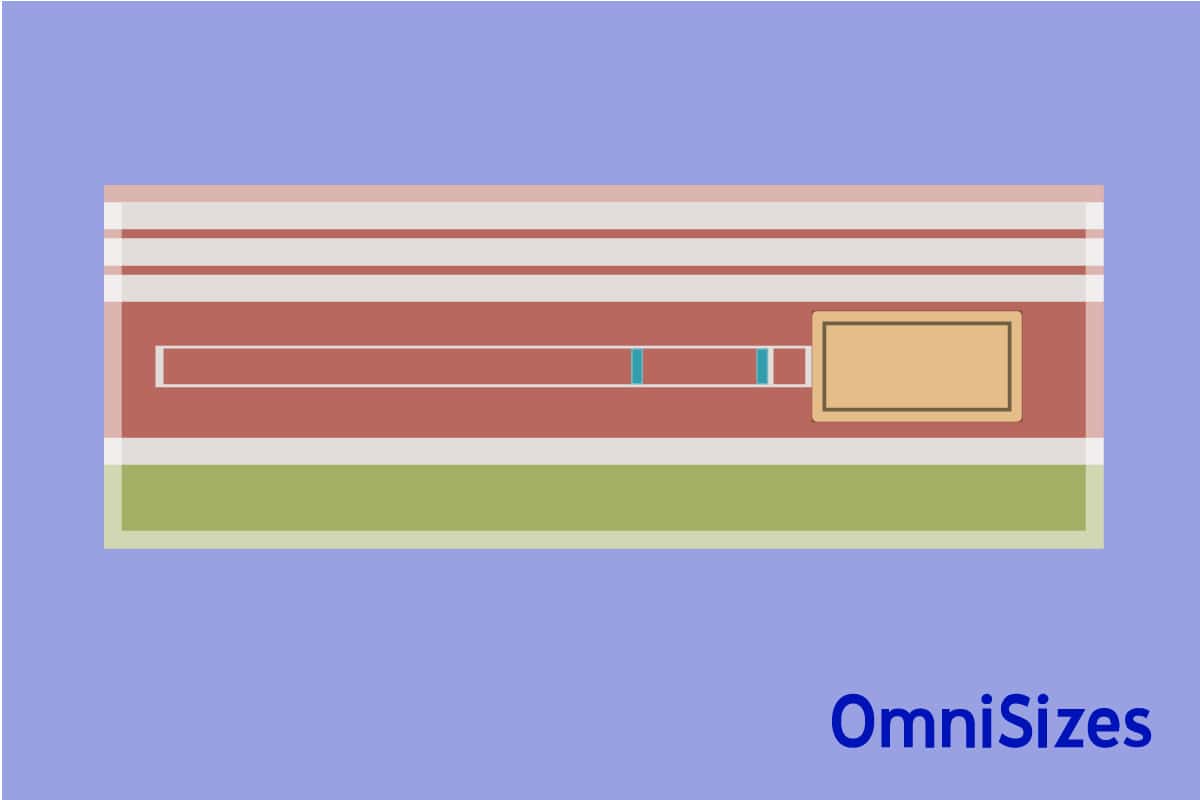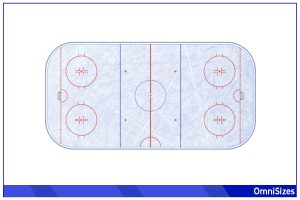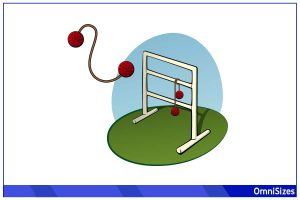Long jump pit dimensions are fundamental to the sport of long jump. This particular aspect of the sport has evolved over time, reflecting the needs and feedback of athletes, coaches, and governing bodies.
Standard dimensions for a long jump pit typically measure 2.75 meters × 9 meters or approximately 9 × 29.6 feet. However, some variations in size may exist between different leagues or organizations, depending on specific regulations and requirements.

Today’s guide will discuss the components of a standard long jump pit, its dimensions for various leagues, and tips for creating your own long jump pit for backyard training.
Long Jump Pit Dimensions and Components
The long jump is a track and field event where athletes sprint down a runway and jump as far as possible into a sand-filled pit. To maintain uniformity and fairness in competitions, certain components and their dimensions are standardized.
1. The Runway
The runway is where athletes gain the speed required for their jump. It is a straight path that leads up to the takeoff point.
- Length: The standard length is between 40 meters to 45 meters. The exact length can vary depending on the competition level, but it’s always long enough to let athletes achieve their maximum speed.
- Width: Its width is usually around 1.22 meters or roughly 48 inches.
- Material: Predominantly made of polyurethane or other synthetic materials, it offers optimal grip and reduces the risk of slipping.
2. The Takeoff Board
This is where athletes take their leap. The takeoff board is crucial for ensuring that jumps are measured accurately.
- Positioning: The board is placed before the pit. For elite competitions, the edge of the board closest to the pit is 1 meter away from the pit for women and 1.5 meters for men.
- Size: The board measures 1.22 meters in length (about 48 inches) and is 20 centimeters or nearly 7.9 inches wide.
- Material: Made from white wood or another similar material, it’s distinguishable from the rest of the runway for visibility.
3. The Sandpit
After taking off, athletes land in the sandpit. This pit is designed to provide a soft landing and make it easy to measure the jump’s distance.
- Length: Standard pits are 2.75 meters or 9 feet. This width ensures that athletes, even when jumping at an angle, will land in the sand.
- Width: The pit extends 9 meters or 29.6 feet in length from the takeoff board. This length accounts for the longest jumps and ensures every jump can be accurately measured.
- Depth: The sand depth is typically around 30 centimeters or 11.8 inches. This depth is optimal for cushioning the athlete’s landing without causing injuries.
- Sand Quality: The sand used is free from stones and debris. It’s also regularly raked to maintain consistency and provide a clear imprint of the athlete’s landing.
Global Standards for Long Jump Pit Dimensions
Depending on what level or league you’re competing in, the dimensions of the long jump pit will vary. Let’s go over the global benchmarks set for long jump pit dimensions.
1. IAAF (International Association of Athletics Federations)
The IAAF, known today as World Athletics, sets the global standards for most track and field events, including the long jump.
- Runway: The recommended length for international competitions is 45 meters, with a width of 1.22 meters.
- Takeoff Board: Positioned 1 meter (for women) and 1.5 meters (for men) from the start of the pit. It’s 20 centimeters wide and 1.22 meters long.
- Sandpit: Typically 2.75 meters wide and extends to a minimum length of 9 meters. The sand depth is usually kept around 30 centimeters.
2. NCAA (National Collegiate Athletic Association)
The NCAA, which governs collegiate sports in the United States, largely aligns with IAAF standards but has some nuances.
- Runway: A minimum length of 40 meters is maintained, with the same width of 1.22 meters.
- Takeoff Board: The board’s placement is identical to IAAF standards. The size remains consistent at 20 centimeters by 1.22 meters.
- Sandpit: The width is kept at 2.75 meters with a length that matches IAAF recommendations. Sand depth is consistent at around 30 centimeters.
3. High School Regulations
High school competitions, especially in the US, are often governed by state or regional athletic associations. While they aim to be consistent with global standards, there are some variations due to factors like space, budget, and safety concerns.
- Runway: Most high school runways are between 40 meters to 45 meters in length with a standard width of 1.22 meters.
- Takeoff Board: The board is 20 centimeters wide and 1.22 meters long. Its placement from the pit can sometimes vary but often aligns with the IAAF standards.
- Sandpit: Width is consistent at 2.75 meters. The length and depth might slightly differ but usually hover around IAAF and NCAA recommendations.
Tips for Setting Up Your Own Pit
Thinking of training for the Olympics? The best place to start is in your backyard. Follow these tips to design and set up the perfect long jump pit for at-home training!
1. Choose the Right Location
- Space: Before anything else, assess the space you have. A typical pit, including the runway, requires a significant area. Ideally, you’d want at least 50 meters in length to accommodate both the pit and the runway.
- Ground: Opt for a level ground. Uneven terrains can lead to incorrect measurements and potential injuries.
2. Gather Necessary Materials
- For the Runway: Polyurethane or synthetic materials are optimal. However, for a casual setup, even a well-maintained grass path can serve as a runway.
- For the Sandpit: You’ll need fine, debris-free sand. The kind used in construction or beach volleyball pits often works well.
- Boundary Markers: To define the pit and runway, use white paint or chalk. For a more permanent solution, consider embedding thin plastic or wooden strips.
3. Setting Up the Runway
- Length and Width: Aim for a length of 40-45 meters and a width of 1.22 meters, even if it’s just a casual setup.
- Surface: Ensure the surface is smooth. If using grass, mow it regularly. For synthetic materials, occasional sweeping might be needed to remove debris.
4. Preparing the Sandpit
- Dimensions: Aim for a width of 2.75 meters and a minimum length of 9 meters. If space is limited, adjust accordingly but maintain the width to ensure safe landings.
- Depth: Aim to maintain a sand depth of around 30 centimeters. This depth provides a cushioned landing.
5. Positioning the Takeoff Board
- Placement: The board should be 1 to 1.5 meters away from the start of the pit. Its exact position can vary based on the jumper’s preference.
- Visibility: If you’re not using a standard white board, mark the area clearly. It helps the jumper identify the takeoff spot.






